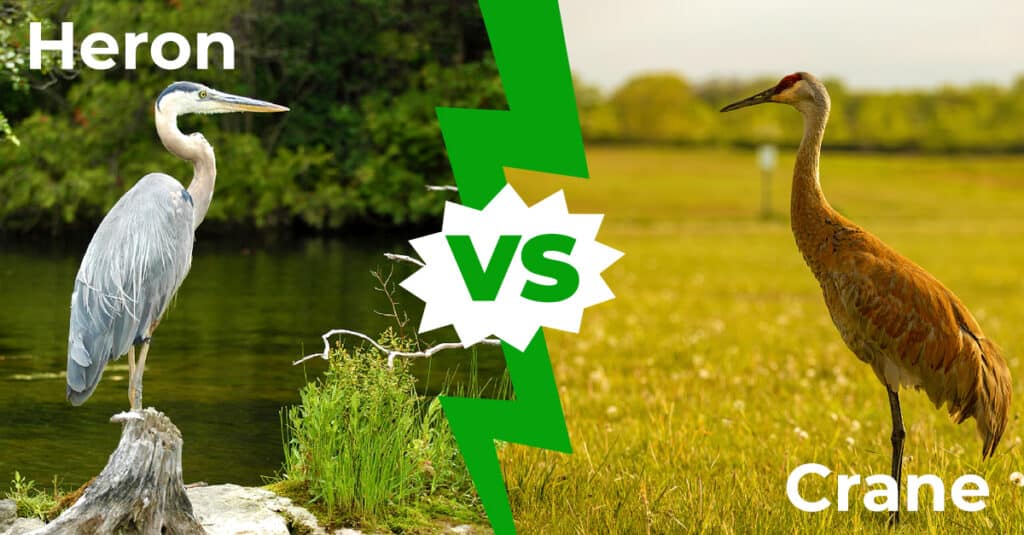Imagine a tranquil wetland, bathed in the golden light of dawn. As the mist lifts, a majestic, long-legged bird emerges from the reeds, its feathered silhouette an iconic symbol of tranquility and wilderness. But is it a heron, a crane, or a stork? This trio of avian giants often leave us baffled, seemingly interchangeable with their slender necks, long legs, and graceful flight. Yet, beneath the surface of their shared elegance lies a fascinating world of distinct adaptations, habitats, and behaviors.

Image: blogdigger.com
This article delves into the intricate world of these magnificent birds, exploring their unique characteristics and unraveling the subtle distinctions that set them apart. By understanding their individual traits and ecological roles, we can gain a new appreciation for the interconnectedness of nature and the wonder of biodiversity.
The Heron Family: Masters of Patience
Herons are members of the Ardeidae family, a group that includes egrets and bitterns. These birds are predominantly found in wetlands and along shorelines, perfectly adapted for their habitat. Their long, pointed beaks, sharp talons, and incredible patience make them formidable fishers.
-
A Patient Hunter: Herons stand motionless for extended periods, their keen eyesight watching for any sign of movement below the water’s surface. When prey emerges, their lightning-fast reflexes deliver a precise strike, securing their meal.
-
A Diverse Family: The heron family boasts a diverse range of species, with variations in color, size, and beak shape. The Great Blue Heron, a towering presence, is a common sight in North America, while the Little Blue Heron, with its vibrant blue feathers, prefers warmer climates.
-
Finding a Home: Herons are typically solitary birds, nesting in trees, bushes, or on the ground. They are adaptable and can thrive in a variety of habitats, from freshwater marshes to saltmarshes and even urban environments.
The Crane Family: A Legacy of Ancient Elegance
Cranes belong to the Gruidae family, a distinct group of birds that are more closely related to rails and bustards than to herons. Their long, elegant necks, long legs, and graceful movements have inspired awe and wonder for centuries.
-
Global Travelers: Unlike herons, cranes are migratory birds, embarking on epic journeys across continents. The Siberian Crane, for instance, flies from its breeding grounds in Siberia to wintering areas in India, covering thousands of miles during its migration.
-
A Symphony of Calls: Cranes are known for their complex, haunting calls, a distinctive feature that adds to their aura of mystery. Their elaborate courtship displays involve intricate dances and synchronized movements, a sight that has captivated birdwatchers for generations.
-
Family Bonds: Cranes are highly social animals, forming strong family bonds that can last for years. They live in pairs or flocks, often gathering in large numbers at traditional gathering places, known as booming grounds, during the breeding season.
The Stork Family: Delivering Hope and Tradition
Storks, members of the Ciconiidae family, are recognized for their distinctive long legs, long necks, and bill, and are often associated with good luck and the arrival of new life.
-
Symbiotic Relationships: Storks are known for their unique symbiotic relationship with humans. In many cultures, they are revered for their association with prosperity and fertility. Their nests are often found on rooftops and chimneys, adding an enchanting touch to human settlements.
-
Exceptional Diet: Storks are opportunistic feeders, primarily consuming insects, amphibians, reptiles, and even small mammals. Their long, pointed beaks enable them to easily search for food in fields and wetlands.
-
Master Builders: Storks are skilled nest builders, often using sticks, twigs, and even pieces of plastic to create their homes. These nests can become massive structures, housing generations of storks.

Image: a-z-animals.com
Distinguishing Features: A Look Closer
While at a glance, herons, cranes, and storks may appear similar, closer inspection reveals intriguing differences.
-
Neck Posture: Herons typically hold their necks in an “S” shape, while cranes tend to extend their necks straight. Storks, on the other hand, often hold their necks in a more curved position, almost as if they are bending their necks backward.
-
Bill Shape: Heron beaks are long and pointed, ideal for spearing fish. Crane beaks are slightly shorter and straighter, adapted for a more generalized diet. Stork beaks are long and slightly curved, designed for probing and grasping prey.
-
Leg Length: Generally, cranes have the longest legs among the three, followed by storks, and finally herons. These differences in leg length reflect their unique adaptations to their respective habitats and hunting strategies.
Heron Vs Crane Vs Stork
In Conclusion:
Herons, cranes, and storks, while seemingly interchangeable, offer a fascinating glimpse into the diversity and beauty of nature. By understanding their individual traits, adaptations, and ecological roles, we can develop a deeper appreciation for their interconnectedness and the delicate balance of the natural world.
If you’ve enjoyed this journey into the world of heron, crane, and stork, consider sharing your observations and experiences with these magnificent birds. Let us continue to learn and explore the wonders of our shared planet.






